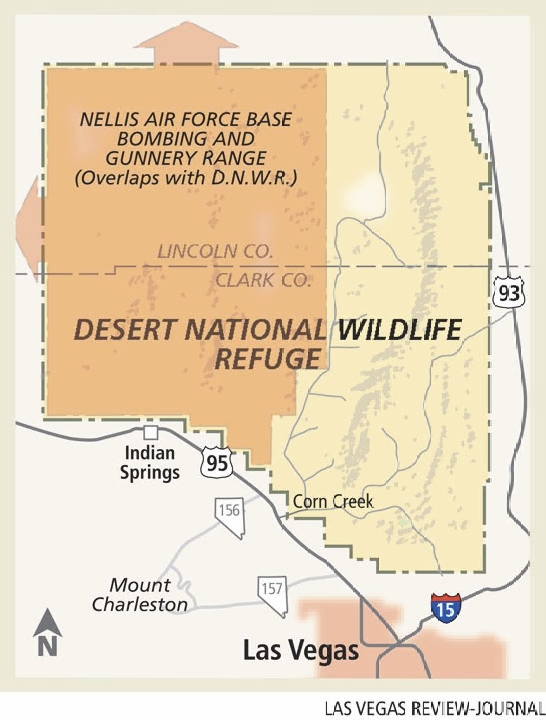Desert National Wildlife Refuge celebrating 75 years
Desert National Wildlife Refuge will turn 75 next week.
To mark the occasion, visitors to the largest and one of the oldest refuges in the 48 contiguous states can celebrate by, of course, taking a hike.
One, in fact, is planned for a limited number of hikers to historic Hidden Forest Cabin. The rustic cabin sits in the shade of ponderosa pines at about the 8,000-foot elevation in the Sheep Mountains, more than an hour's drive through the refuge over a bumpy, washboard road on the northwestern outskirts of the Las Vegas Valley.
The cabin, which was listed on the National Register of Historic Places in 1975, was restored in 2009 through a $30,000 project funded by the sale of public land in Southern Nevada.
Historians believe the cabin could have been built in the late 1880s or 1890s and used by hunters, trappers, prospectors and maybe outlaws in its early years.
It was standing in the 1920s at the beginning of Prohibition, when they think bootleggers lived in it while distilling moonshine before the federal game range was established in 1936.
The hike is just one selection from a weeklong menu of public events and activities, beginning today with a count of bird nests to commemorate International Migratory Bird Day beginning 8 a.m. at the U.S. Fish and Wildlife Service's Corn Creek Field Station, 23 miles northwest of Las Vegas.
On Monday and Tuesday, refuge staff and volunteers will construct a new trail, Whispering Ben Trail, at Corn Creek.
Next Saturday , the 11-mile roundtrip hike to Hidden Forest Cabin will be guided by members of the Red Rock Canyon Interpretive Association for a group limited to 15 people who can register by calling 515-5367.
That same day, a birthday party for the refuge will be held complete with a pioneer-style cookout, wildlife games and crafts.
For the most part, other than a reduction in the size and a different name for it over the years, the more than 1.5 million acres of scenic landscape that make up the refuge have not changed much, said Manager Amy Sprunger.
Most of the changes have been at the Corn Creek Field Station, where the birthday party will be held.
"We've improved springs and added wildlife water developments ," she said.
The birthday events will be held one day and 75 years after President Franklin D. Roosevelt established what was called the Desert Game Range on May 20, 1936, for "the conservation and development of natural wildlife resources."
It was not the nation's first wildlife refuge. FDR's distant cousin, President Theodore Roosevelt, established Florida's Pelican Island as the first national wildlife refuge in 1903 to protect herons, egrets and other birds from being killed for their feathers that were fashionable then.
Nor is the desert refuge the nation's largest. Alaska has 11 that are bigger including Arctic National Wildlife Refuge at 19.3 million acres and Kodiak and Kenai refuges, which are roughly 2 million and 1.9 million acres, respectively.
Originally, the Desert Game Range encompassed 2.25 million acres, including part of the Spring Mountains and what is now Red Rock Canyon National Conservation Area.
As its name implies, it was set aside to preserve habitat for game animals, particularly desert bighorn sheep .
Today the refuge's bighorn sheep population numbers about 800 animals and about 15 tags are issued to hunters annually, depending on the harvest permitted by the Nevada Department of Wildlife.
In 1939, Corn Creek Ranch, where George and Clara Richardson lived in 1919, was acquired for the refuge field station. The Las Vegas-Tonopah Railroad had operated in that area from 1906 until 1917. After it was shut down, its wooden ties were used to construct Railroad Tie Cabin, which has been preserved at Corn Creek.
The Desert Game Range took on another dimension in October 1940 when 846,000 acres of it were reserved for the War Department to be used as an aerial bombing and gunnery range. The Department of Defense still uses a portion of the refuge for Air Force operations .
"All of the western half is off-limits to the public. It is policed by law enforcement officers and is very difficult to get to," Sprunger said.
Desert Game Range was reduced to about half its original size in 1956 when more than 1 million acres was transferred to the Bureau of Land Management and the U.S. Forest Service to eliminate livestock grazing on the refuge.
Then, on Aug. 31, 1966, the land order that created Desert Game Range was amended to establish Desert National Wildlife Range for sole management by the Bureau of Sport Fisheries and Wildlife, which is now the U.S. Fish and Wildlife Service.
Technically, Desert National Wildlife Range is still the name of refuge. But because it is part of the National Wildlife Refuge System, and is part of a complex of refuges in Southern Nevada that includes Ash Meadows, Pahranagat and Moapa Valley, Sprunger said the range is commonly known as Desert National Wildlife Refuge.
The refuge is home to federally protected desert tortoises and a population of endangered Pahrump poolfish, which thrive in a refugium at Corn Creek that consists of two concrete aquariums filled with artesian spring water.
The refuge is also used by scientists at Desert Research Institute and UNLV to study climate change.
What will the refuge look like 75 years from now?
Sprunger said she expects there will be few changes, if any.
"I don't anticipate the back country looking much different 75 years from today," she said.
Contact reporter Keith Rogers at krogers@reviewjournal.com or 702-383-0308.

















